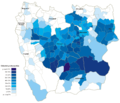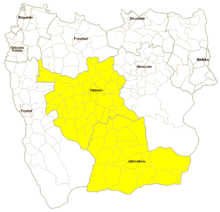Teschen district
The district of Teschen ( Polish : Powiat polityczny Cieszyn ) was a political district in Austrian Silesia in the years 1850–1855 and 1868–1918 / 1920. Its area included parts of the Olsa region (Cieszyn Silesia) in today's states of Poland ( Silesian Voivodeship , Powiat Cieszyński ) and the Czech Republic ( Moravskoslezský kraj , Okres Frýdek-Místek and Okres Karviná ). The seat of the district administration was the city of Teschen, today Cieszyn in Poland and Český Těšín in the Czech Republic. After the First World War , the district fell to Poland and Czechoslovakia .
history
In the years 1850–1855 the Teschen district also included Freistadt and 1868–1901 also Friedek.
In 1880 the district had 101 parishes (49 in the judicial district of Teschen, 32 in the judicial district of Friedek, 20 in the judicial district of Jablunkau). In 1890 there were 102 municipalities ( Žermanice was separated from Horní Bludovice ), on January 1, 1890 103 municipalities (Lomna was separated into Dolní Lomná and Horní Lomná ). On October 1, 1901, the Friedek judicial district became a separate district with 33 parishes. According to this, the Teschen district had an area of 730 km² and comprised 70 communities (49 in the Teschen judicial district and 21 in the Teschen Jablunkau judicial district).
Results of the censuses of 1880, 1890, 1900 and 1910 in the judicial districts of Teschen and Jablunkau:
| 1880 | 1890 | 1900 | 1910 | |
|---|---|---|---|---|
| Judicial district Teschen | 51,099 | 54,663 | 62,044 | 71,809 |
| Polish speaking | 34,551 (69.1%) | 39,258 (73.6%) | 42,380 (70.2%) | 47,982 (68.3%) |
| Czech speaking | 7,536 (15.1%) | 4,912 (9.2%) | 5,320 (8.8%) | 6,033 (8.6%) |
| German speaking | 7,869 (15.8%) | 9,150 (17.2%) | 12,583 (20.9%) | 16,133 (23%) |
| Jablunkau judicial district | 24,413 | 26,738 | 28,987 | 30,743 |
| Polish speaking | 24,371 (97.5%) | 25,607 (97.4%) | 27,614 (97%) | 26,165 (96.4%) |
| Czech speaking | 93 (0.4%) | 63 (0.2%) | 86 (0.3%) | 171 (0.6%) |
| German speaking | 538 (2.1%) | 622 (2.4%) | 773 (2.7%) | 912 (3%) |
Traditionally, after the spin-off of the Friedek district, the district was inhabited by the so-called Teschener Wallachians (Polish Wałasi ) in the north and Silesian Gorals in the south, who spoke the Teschen and Jablunkau dialects . The results of the censuses and other factors affecting national identity are still discussed today (see: Czechoslovak-Polish border conflicts ).
In 1910, 56,924 (55.5%) people were Roman Catholic, 42,738 (41.7%) Protestant, 2,689 (2.6%) Jewish, 201 were of other faith. There were around 5500 (5.5%) immigrants from Galicia , 4300 (0.9%) came from Bohemia and Moravia.
Localities
In 1910, the judicial districts in Teschen and Jablunkau existed in the area of the district ; the following locations were assigned to these:
Jablunkau judicial district:
- Bistrzitz
- Boconowitz
- Bukowetz
- Grudek
- Istebna
- Jablunkau (districts: Biala-Burgrecht, Schigla, Pioseczna )
- Jaworzinka
- Karpentna
- Koniakau
- Koszarzisk
- Lischbitz
- Under Lomna
- Upper Lomna (districts: Upper Lomna, Przelacz)
- Millikau
- Mosty
- Nawsi
- Niedek
- Oldrzychowitz
- Piosek
- Tyra
- Wendrin
Judicial district Teschen:
- Bażanowitz
- Lower Bludowitz
- Bobrek
- Brzezuwka
- Lower Dattin
- Dobratitz (districts: Bukowitz, Dobratitz)
- Nieder Domaslowitz (districts: Kotzurowitz, Niederdomaslowitz, Wolowetz)
- Upper Domaslowitz
- Dzingelau
- Cameraman Ellgoth
- Grodischcz
- Gumna
- Gutty
- Haslach
- Hnojnik
- Kojkowitz
- Konskau
- Kotzobendz (districts: Allodial Ellgoth , Kotzobendz, Thiergarten / Podobora / Zwierzyniec)
- Krasna
- Lower Lischna
- Upper Lischna
- Mistrzowitz (districts: Koniakau, Mistrzowitz)
- Mönichhof
- Mosty
- Niebory
- Ogrodzon
- Pastwisk (districts: Boguschowitz , Kalembitz , Pastwisk)
- Pogwisdau (districts: Marklowitz , Pogwisdau)
- Punzau
- Roppitz
- Rzeka
- Schibitz (districts: Blogotitz , Schibitz)
- Schöbischowitz (districts: Nieder Schöbischowitz, Ober Schöbischowitz, Pitrau)
- Schumbarg
- Smilowitz (districts: Rakowetz, Smilowitz)
- Stanislowitz
- Teschen (districts: Brandeis, Freistädter Vorstadt, Kleine Wiese, Mühlgraben, Sachsenberg, Steinplatz, Teschen)
- Lower Tieritzko
- Ober Tierlitzko
- Lower Toschonowitz
- Ober Toschonowitz (districts: Ober Toschonowitz, Poleniny)
- Trzanowitz (districts: Nieder Trzanowitz, Ober Trzanowitz)
- Trzynietz
- Trzytiesch
- Wielopoli
- Zamarsk
- Nieder Zukau
- Upper future
- Zywotitz
See also
- List of districts and statutory cities in the Duchy of Upper and Lower Silesia
- Teschen district
- Powiat Cieszyński
Individual evidence
- ↑ Janusz Gruchała, Krzysztof Nowak: Śląsk Cieszyński od Wiosny Ludów do I wojny światowej (1848–1918) . Starostwo Powiatowe w Cieszynie, Cieszyn 2013, ISBN 978-83-935147-3-1 , p. 12-13 (Polish).
- ↑ a b Kazimierz Piątkowski: Stosunki narodowościowe w Księstwie Cieszyńskiem . Macierz Szkolna Księstwa Cieszyńskiego, Cieszyn 1918, p. 4–5 (Polish, online ).
- ^ A b c Ludwig Patryn (ed): The results of the census of December 31, 1910 in Silesia . Troppau 1912 ( online ).
- ↑ Kazimierz Piątkowski: Stosunki narodowościowe w Księstwie Cieszyńskiem ( Polish ). Macierz Szkolna Księstwa Cieszyńskiego, Cieszyn 1918, pp. 12, 72-75.
- ↑ Janusz Gruchała, Krzysztof Nowak: Śląsk Cieszyński od Wiosny Ludów do I wojny światowej (1848–1918) . Starostwo Powiatowe w Cieszynie, Cieszyn 2013, ISBN 978-83-935147-3-1 , p. 20 (Polish).
- ↑ Śląsk Cieszyński od Wiosny Ludów ..., 2013, p. 16.







